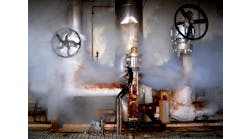This Month’s Puzzler
Our batch reactor (see Figure 1) has worked flawlessly until the last outage. Corporate quality control is screaming bloody murder about product contamination. We switched some of our ingredient suppliers a month before the outage and only ran a few batches before the outage.
I’ve looked over a list of construction changes made during the outage. These included installation of a larger catalyst pump and replacing some corroded control valves and the usual corroded steam traps. Also, during the addition of a third impeller at the top of the reactor to improve yield, we found tip damage to one of the four-blade pitched impellers underneath. We swapped it for a smaller axial high-efficiency impeller (the only one available), and made a few programming changes.
Recently, the steam expansion joint collapsed but I don’t see how that’s a factor in this investigation. Also, despite complaints by operations, we now have reduced the cost of the clean-in-place (CIP) step by flushing the reactor every third batch instead of every batch; it’s a bright idea from our corporate engineers. We continue to flush the static mixer because of the reactivity of the catalyst and the high viscosity of liquid blended with it.
Did the change in the CIP frequency affect our quality? Could it stem from a quality control problem with our ingredients? Could the change in impeller type or size of the bottom impeller be the cause? Should I be looking at the programming? Is it really contamination or is something else going on?
Carefully Review Your Control Options
Consider this:
1. Try to identify contaminants in the batch product. Check all reactant chemicals and additives from new suppliers to see if impurities from them are the source of the problem.
2. As we know, sometimes seemingly minor changes in equipment and/or raw materials and additives could cause unanticipated problems. In one incident I recall, seemingly minor changes in baffle height, liquid level, and agitator speed in the reactor were identified as the sources of product quality problems.
A. Check to see if any of the chemicals (including their constituents in ppm levels) could cause corrosion of the reactor internals, including the new impeller.
B. Check materials of construction new pump and control valve — this should include not only trim, but also other components such as mechanical seal, O-rings, packing and other components.
C. Check if there are changes in operation/composition of the hot water, steam, caustic or catalyst systems.
3. Because the problem statement says contamination, I assume the extent of reaction has not changed. If that is not so, (and your changes have caused change in the extent of reaction and byproduct) you may need to look at batch programming and variables that could affect reaction rates (e.g., agitation, number and type of impellers, temperature progression and others). Make sure flowmeters and totalizers are calibrated periodically and are working properly. In addition, improper installation of flowmeters could cause meters to be unreliable.
4. Have there been any changes in sampling and analytical techniques? —see if they could be causing the problems.
GC Shah, consultant
Houston
Sample, Sample, Sample
I hope you keep a meticulous sample history of your products. Do chemical analysis on samples before the equipment changes and before the ingredient changes; compare these to the samples from the period before the new equipment when the new ingredients were introduced; then, compare these two sets against the current samples produced by the reactor. Next, do then and now samplings of the ingredients. Finally, compare the catalyst fresh from storage against what winds up in the reactor.
As for the corrosion, it seems oddly typical that the longer a problem persists, the easier it is to ignore. Things like a “chipped” agitator blade gets excused with a shrug. Did you think that maybe it wasn’t a chip at all but perhaps something like stress corrosion cracking? Pull the old impellers out of the boneyard; I’m sure you’ll find a few of them: cut samples and do metallurgical studies on them — including electron microscopy. Inspect the old equipment for corrosion. Inspect the reactor: you may find some over-looked surprises. Sample old pipe from the boneyard: hopefully, you tagged these carefully for future study.
I’m not sure corporate had a bright idea. Try going back to the old CIP procedure and see if quality improves. Then, you can resolve how the CIP affects corrosion; this is a common problem. When I worked at Anheuser-Busch, corrosion caused by CIP was a continual, nagging issue.
Dirk Willard, consultant,
Wooster, Ohio
Top Puzzlers
Over the years Chemical Processing has helped many readers find practical solutions to their puzzling process problems. Here is a list of the top 5 Process Puzzler columns based on pageviews.
Process Puzzler: Fully Fix a Fatal Flaw
Proposed revisions to a thermal oxidizer system don’t suffice.
Process Puzzler: Deal with a Decanter that Can't
Readers recommend ways to save a standing separator.
Process Puzzler: Preempt Pump Problems
Readers suggest several options to improve reliability
Deftly Diagnose a Dust Collector
Consider upstream operations as the potential cause of sudden problems
Process Puzzler: Forget About an Easy Fix
Recreating missing equipment data requires significant effort

